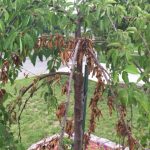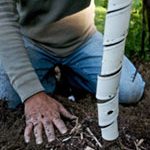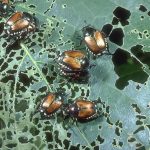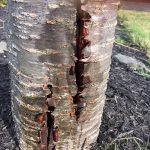Here in central Missouri , we went from one of the warmest Novembers on record to drastically cold weather by the end of December. Plus, we are very, very dry. How is this going to affect our trees, shrubs, and perennials?
Trunk Damage – If you stand outside, and all is quiet, you can hear bark popping on

trees. This does cause damage to tree trunks, opening the bark for possible infection if conditions are wet next spring. (Remember the damaged cherry trees in the summer of 2016?) Plus, these sunny days encourage the sap to run which freezes when the sun sets, expanding and causing bark to split.
What can be done to protect our trees? Large, well established trees can easily  survive this bark popping. Younger and thin-barked trees don’t fare so well. Wrapping the trunks in November helps to reduce winter damage. Certain trees are known to have thinner bark and may be more susceptible to freeze cracking, like Japanese maple, cherry, and plum.
survive this bark popping. Younger and thin-barked trees don’t fare so well. Wrapping the trunks in November helps to reduce winter damage. Certain trees are known to have thinner bark and may be more susceptible to freeze cracking, like Japanese maple, cherry, and plum.
Damage on Evergreens – Prolonged cold spells prevent roots from transporting moisture to wind  dried needles and leaves of evergreen shrubs and trees. Damage occurs during long periods of frozen ground and windy conditions. The solution? Apply Wilt-Pruf in early November to ALL evergreens, needle and broadleaf types. Next spring? Probably some pruning will be needed.
dried needles and leaves of evergreen shrubs and trees. Damage occurs during long periods of frozen ground and windy conditions. The solution? Apply Wilt-Pruf in early November to ALL evergreens, needle and broadleaf types. Next spring? Probably some pruning will be needed.
Wet or Dry….Which is Better? Wet, saturated soils cause more damage to roots as frost heaving tears up fine root hairs. Dry soils allow roots to fare better, but the danger of plants being dry in addition to being subjected to these cold temperatures is that they won’t handle the cold as well. Borderline hardy plants will suffer winter damage from simply being too dry. The solution? Water deeply and thoroughly at least 3 days before temperatures plummet. It’s too late to water now, but if we have a reprieve (the ground thaws and temps stay above freezing for 3 weeks) and still do not receive good rain or snowfall, a good soaking may be in order.

The Good Side: Killing Japanese beetle larvae – Long periods of freezing weather without the benefit of snow cover will freeze deeply, killing out insect larvae hibernating in the soil. According to the Missouri Dept. of Conservation, Japanese beetle larvae are killed when soil temperatures reach 15 degrees. Are we there yet? Since temps were so warm this fall, the larvae may not have been very deep when the sudden cold hit. Let’s hope for a reduction in Japanese Beetle populations this year!!!
But with every good thing, there is another side: the cold can affect the good bugs too. Regardless, it will be an interesting spring. We may continue to see very unusual things happening in our landscapes.

